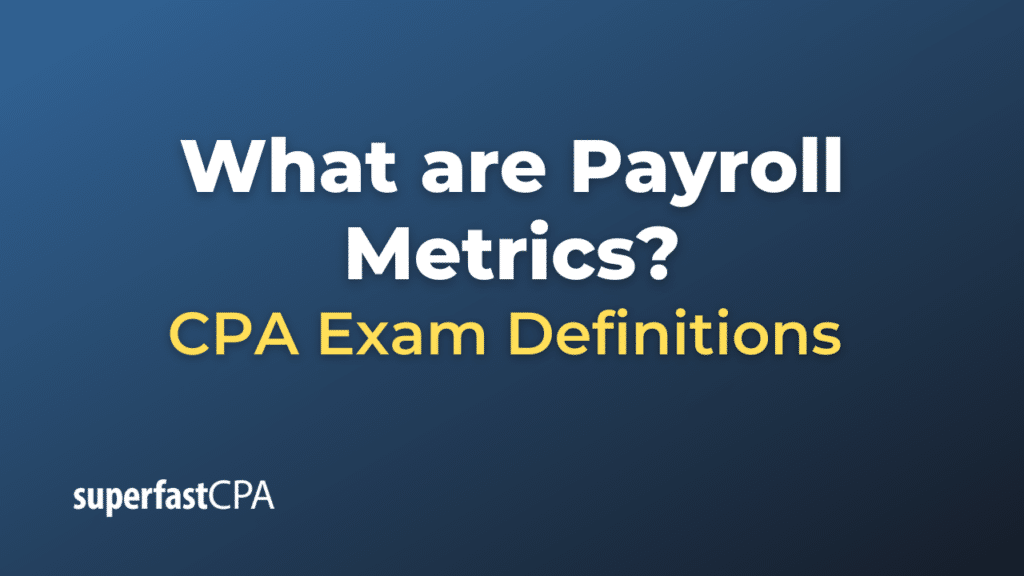Payroll Metrics
Payroll metrics are measurements used by organizations to assess the effectiveness and efficiency of their payroll process. These metrics provide valuable insights into the cost, accuracy, and timeliness of payroll, and can help a company identify areas for improvement. Here are some examples of common payroll metrics:
- Cost per Payroll Process: This measures the total cost associated with running payroll, including software costs, labor costs, and any other associated costs. It can be calculated for each payroll run and can be used to evaluate the efficiency of the payroll process.
- Error Rate: This measures the number of errors made in the payroll process, such as incorrect pay rates, incorrect tax withholdings, or missed payments. This can be expressed as a percentage of total payroll transactions.
- Payroll Efficiency: This measures the time it takes to complete the payroll process. This can be broken down further to assess the efficiency of specific tasks, like data entry, calculations, and check distribution.
- Compliance Rate: This measures the company’s compliance with applicable labor laws and tax regulations. This can be assessed by tracking the number of violations or penalties incurred over a certain period.
- Employee Queries: This measures the number of payroll-related questions or concerns raised by employees. A high number of queries could indicate a lack of clarity or accuracy in the payroll process.
- Overpayment and Underpayment: This measures the number and amount of overpayments and underpayments made to employees. Regular occurrences of overpayment or underpayment could suggest issues with data accuracy or process inefficiencies.
- Time to Resolve Payroll Discrepancies: This measures the average time it takes to resolve payroll errors or discrepancies. A longer time may indicate inefficiencies in the payroll process.
By tracking these metrics, companies can gain a deeper understanding of their payroll operations, identify areas of concern, and make data-driven decisions to improve payroll efficiency and accuracy.
Example of Payroll Metrics
Let’s consider a company called “BrightTech Solutions” that is trying to analyze and improve its payroll process. Here’s how it might use different payroll metrics:
- Cost per Payroll Process : BrightTech calculates that it spends $1,500 on each bi-weekly payroll process. This includes the payroll software subscription, the salary of the payroll clerk, and the bank charges for the transfers.
- Error Rate: Over the past year, BrightTech has processed 26 payrolls (every two weeks) and made 10 errors. So, its error rate is (10 errors / 26 payrolls) * 100% = 38.46%.
- Payroll Efficiency: BrightTech records that it takes approximately 8 hours to process each payroll.
- Compliance Rate: In the past year, BrightTech was penalized once for a late tax payment. Thus, it had a non-compliance instance in 1 out of 26 payrolls, giving it a compliance rate of about 96.15%.
- Employee Queries: Over the year, BrightTech’s HR department received 50 payroll-related queries from employees.
- Overpayment and Underpayment: BrightTech had two instances of overpayment and one instance of underpayment during the year.
- Time to Resolve Payroll Discrepancies: On average, it took BrightTech 3 days to resolve each payroll discrepancy.
Analyzing these metrics, BrightTech might realize it needs to improve its error rate and reduce the number of employee queries, which might be interconnected. It might also work on its processes to avoid penalties and improve its compliance rate. It could also look for ways to improve the efficiency of its payroll process, perhaps by upgrading its payroll software or providing additional training to its payroll clerk. By measuring and tracking these metrics over time, BrightTech can gauge the impact of any changes it makes and continue to refine its processes.













